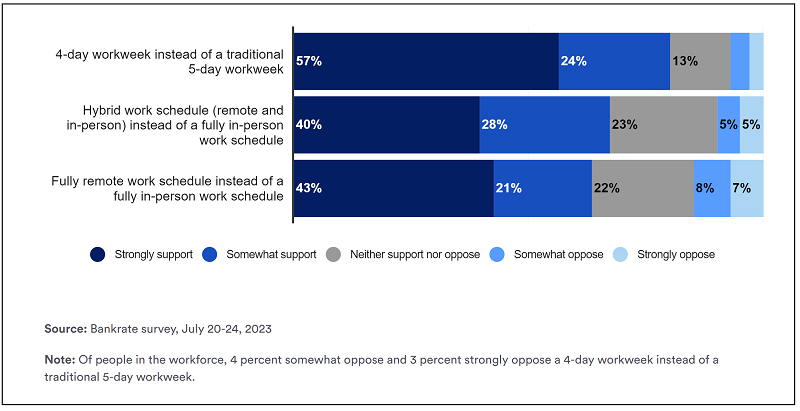The evolution of work models has brought about significant changes in how and where we work. Two prominent models that have gained traction are remote work and hybrid work. In this article, we’ll explore the differences between these models, how they overlap, examples of hybrid work setups, and the challenges faced by individuals on a hybrid work schedule.
Remote Work vs. Hybrid Work: Understanding the Differences
Remote work refers to an arrangement where employees primarily work from spaces outside of the traditional office, such as their homes, coworking spaces, or other distributed locations. Communication and collaboration typically occur through digital tools and virtual platforms. On the other hand, hybrid work involves a mix of remote and in-office work. The hybrid model specifically includes scheduled office days or activities that require physical presence, distinguishing it from full-time remote work. Hybrid employees have the flexibility to work remotely for part of the week or month, while also coming into the office for designated days to benefit from in-person interaction such as meetings, brainstorming sessions, or team-building events. There is certainly overlap between these two work models which is why some may use remote and hybrid interchangeably, but they are not one in the same. It may help to think of hybrid as a subset of remote work.
Examples of Hybrid Work Setups
- Flexible Work Hours: Employees have the freedom to choose their work hours and locations, balancing remote work with in-office presence based on job requirements and personal preferences.
- Scheduled Office Days: Teams may have designated days for in-person meetings, collaboration sessions, or team-building activities, fostering a sense of camaraderie and collaboration. Many hybrid workers want the option to work-near-home on scheduled office days. This is where many choose to leverage neighborhood coworking spaces as a way to have face-to-face meetings with colleagues while avoiding a long commute.
- Remote Work Opportunities: Employees can work remotely for a portion of the week or month, enjoying the benefits of flexibility and reduced commuting time while maintaining productivity and connectivity.
According to recent survey by consumer financial services company Bankrate, 89% of full-time workers favor a 4-day workweek, hybrid schedule, or remote work. Additionally, 68% of full-time employees support a hybrid model instead of fully in-office work, indicating a widespread adoption of this flexible work model across industries and organizations.
Challenges for Those on a Hybrid Work Schedule
- Communication and Collaboration: Balancing remote and in-office communication channels can lead to potential miscommunications, delays in information sharing, and difficulties in maintaining team cohesion.
- Work-Life Balance: Managing work responsibilities while navigating between remote and office environments can blur the boundaries between work and personal life, impacting overall well-being and stress levels.
- Technology and Infrastructure: Dependence on technology for remote work requires reliable internet connections, access to necessary software and tools, and IT support to address technical issues promptly.
- Isolation and Engagement: Remote workers may experience feelings of isolation or disconnection from the team, missing out on social interactions and networking opportunities available in physical office settings.
Best Practices for Workers on a Hybrid Schedule
- Clear Communication Protocols: Establish clear communication guidelines, use collaborative platforms, and schedule regular check-ins to ensure transparent communication and alignment among team members.
- Work-Life Integration: Encourage employees to set boundaries, establish dedicated workspace at home, and prioritize self-care activities to maintain a healthy work-life balance.
- Training and Support: Provide training sessions, resources, and technical support to help employees navigate remote work tools, troubleshoot issues, and enhance digital literacy.
- Flexibility and Adaptability: Emphasize flexibility in work schedules, task assignments, and work arrangements to accommodate individual needs, preferences, and responsibilities.
- Utilize Coworking Spaces and Flexible Offices: Coworking spaces and flexible office setups can serve as viable solutions for individuals on a hybrid work schedule. These spaces offer professional environments, amenities, different office plan options such as Flex Desk Memberships, Virtual Office Plans and All Access Passes, networking opportunities, and a change of scenery which all have an impact on productivity, collaboration, and work-life balance.
The remote and hybrid models represent modern work paradigms that offer flexibility — something in which workers have some to expect. Understanding the differences between these models, addressing challenges faced by individuals on hybrid work schedules, and implementing effective solutions can help organizations and employees thrive in the evolving work landscape. Coworking spaces and flexible office spaces play a crucial role in providing conducive work environments and supporting hybrid work arrangements, making them valuable assets in the transition to a more flexible and agile work culture.
Check out our flexible office space options to support your hybrid or remote work schedule. If you’re unsure of the best solution, contact us and we’ll steer you in the right direction.


